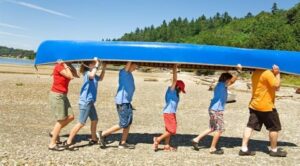In the afterglow of a buyout that took 12 years to negotiate, the Vellano cousins carry on the entrepreneurial tradition at Vellano Bros. Inc.
By Howard Muson in Family Business Magazine
Five guys named Vellano in the sewer business had good reason to break out the champagne at the start of 1992. Early in January their fathers signed a buyout agreement under which the five cousins—Jim Vellano and his brother, John, and Joe Vellano and his brothers Tony and Paul—became full owners of Vellano Bros., a $30 million water pipe construction and distribution company with seven supply centers across New York State.
The two sets of cousins endured almost 12 years of stop-start negotiations and spent hundreds of thousands of dollars in legal, accounting, insurance, and appraisal fees before buying out their fathers. The signing itself was almost anticlimactic since the younger crowd had been virtually running the company for a decade. Their fathers retired in 1987 and are now living in Florida.
The five young Vellanos learned the business, one might say, from the underground up; as teenagers all five loaded pipe in the yard, drove trucks, and got caked with mud in ditches. But they have become savvy businessmen. In an industry that follows the up-and-down cycles of the construction business, they have learned how to anticipate changes in the economy, how to seek out new opportunities, and how to keep moving the company forward. The Vellanos say they have made a profit in every year since the company was founded in 1946, which has given them the means to indulge their hobbies, not all of them profitable—like the two minor league baseball clubs they once owned, the St. Petersburg Cardinals and the Hamilton, Ontario, Redbirds.
Howard Muson, editor of Family Business, recently interviewed the Vellanos at their warehouse-headquarters in Latham, New York, just outside Albany. Although Joe Vellano, 43, the president, and his cousin Jim Vellano, 41, the secretary-treasurer, seemed to be chief spokesmen for the Vellano five, they made sure to invite their three equal partners to join the discussion. Clearly, this is an all-for-one, one-for-all operation. Just prior to the interview Joe had been in England, where he and cousin John had been exploring what they see as the next big development in the business, so-called trenchless technology, a new method of repairing underground pipe without digging up roads and halting traffic—like doing angioplasty under miles of pavement.
Family Business: Why did the buy-out take so long?
Joe Vellano: We had tried to transfer ownership three, four, five times, and it just wasn’t ready to happen. It was like trying to mate two elephants who took a long time before they got in the right mood. Then the 2036(c) law suspending estate freezes came along, and that held us up even more.
Jim Vellano: We got to the point a couple of times where the papers could have been signed but weren’t because of differences in opinion or skepticism about whether things would work. It’s funny, when we had the most consulting help, we were the furthest away. When we had the least help, it happened. An insurance guy walked in the door and said, “I can get this done for you.” And he did.
FB: What was the biggest hang-up in the deal? I gather your fathers weren’t eager to let go.
Jim: Each of our fathers owned 50 percent of the business. One brother had three sons and the other had two sons. So the question was: Should each of the five sons own 20 percent, or should each family own 50 percent?
If each son was going to own 20 percent, then one brother had to sell 10 percent to the other. But then one family would be in control. We decided to eliminate that possibility. We made it a 50-50 split between the families; Joe and Tony and Paul divided their half three ways, and John and I divided ours two ways.
FB: So your fathers did not keep any stock?
Joe: John and Anthony Vellano are now completely out, and we hope they are happy. We will be paying for the buyout for years to come. Actually, if we were to buy this business today we could probably get it a lot cheaper, because the buy-out valuation was done in 1989 and we had our best year in 1988.
FB: Do they still try to second-guess you from Florida?
Joe: We still get calls, once a week or more, saying: “How’s business? Are you having any problems with this or that?” Although they’ve let go, they really haven’t let go. But, you know, they always let us do our jobs. We do the same with our managers. We have systems of control, but we give people space, let them do their jobs. We have learned to respect people’s abilities.
Jim: Yes, that is key—for both family and nonfamily.
FB: You are actually a third-generation business. How did the company get started?
Joe: My grandfather stowed away on a boat sailing from Italy to Boston at the age of 12. He later started a construction company here that was quite vibrant but he had to close it late in the Depression. When my father and uncle came back from serving in World War II, they went into business installing water and sewer-pipe, forming Vellano Bros. in 1946. My grandfather was involved in the company until he passed away in the 1960s.
FB: You are now principally suppliers of all kinds of pipe, safety equipment, and accessories for water and sewer-line construction. How did the change come about?
Jim: When we moved to this location in 1965 we had a large yard where we stocked a lot of equipment for our own use. Local contractors knew we kept surplus inventory and they’d call up to borrow this or that. When the loan slips from other contractors came due my Dad would say: “Call them up and see if they want to either return the stuff or pay for it.” In almost every case the contractor would say: “Send us a bill. And, by the way, do you have such-and-such kind of pipe?” So my Dad got the idea to start the supply business.
FB: How big a company were you when you went into distribution?
Joe: About $600,000. We had two pipeline crews, about six or seven guys in each crew, tops.
Jim: If I remember correctly, we did $250,000 in the first year of the supply business.
Joe: And I think we did $1 million in either the second or third year. Business began to boom in the mid-1960s when New York Governor Nelson Rockefeller got legislation passed for new sewer treatment plants. All of a sudden there were state funds for new water and sewer lines. A few years later, in 1972, the Environmental Protection Agency mandated requirements for all sewers, and we started selling a lot of sewer pipe. OSHA (the Occupational Safety and Health Administration) gave us a nice boost when it mandated safety equipment for workers like oxygen tanks and trench boxes for shoring up the walls of excavations and preventing cave-ins. We sort of hit the whole environmental wave just right. Timing was important.
FB: How did your fathers divide the responsibilities?
Jim: By the 1970s Joe’s father, Anthony Vellano, was running the construction side of the business. My father, John Vellano, ran the distribution side. And by this time the supply business had grown twice as big as the construction business. John felt he had created something of a monster, so in 1972 we divided the company into three parts: Vellano Bros., as the parent company; AnJo Construction, as the construction subsidiary; and A.J. Vel, as the equipment sales and repair subsidiary. A friend of ours labeled my father “The Pipe King,” and that became part of our first logo.
FB: You both went to junior college. How did you learn the business?
Joe: On the job. Each of us worked for the others’ father, except for Jimmy, who worked in the office with his Dad. I also worked with my Uncle John.
Jim: I was doing payroll and payables when I was 12 years old. But we all did everything. We all worked in a ditch. We all drove a truck. We loaded materials, worked at the counter, swept the warehouse, shoveled the snow. As we got older we started quoting prices to customers on the phone, delivering the orders, and coming back and loading up the truck again. At one point we were doing $6 million in business with just four or five employees…
Joe: …and killing ourselves. We were going at it 18 hours a day and it was crazy.
Jim: It was part of our upbringing. Our fathers wanted us to really work and come up a long way. And my grandfather always went by the maxim that you do the best you can with what you have. When we started out in the business we were actually rolling pipe onto the truck and rolling pipe off the truck. We would go out and use bare brawn to do things of this nature.
Joe: They wouldn’t let us use a forklift. They thought we were whipped if we had to use a forklift.
FB: At what point did your fathers start bringing you in on the big decisions?
Jim: I would say that the 1972 decision to split the company came from the younger generation. From about that point we started working a lot better as a family. Our fathers began asking for our input. We would sit in a room and hash things out, go back and forth until we could agree.
FB: So you split the company but made joint decisions on some things?
Jim: On everything.
FB: How did you decide who was going to do which job?
Jim: Each of us found our niche. Paul was a professional football player in the World Football League. Alter he was injured he did some coaching in Maryland; he was in the limelight and it was hard for him to come back to sell pipes. By mutual agreement he came back in 1981 and took charge of A. J. Vel. My brother, John, started his own pipeline construction firm in the late 1970s. After 10 years and some disappointments he dissolved the business. He was promised some ownership and came back as head of AnJo Construction. My cousin Tony went to college and had his own ventures for a few years and then elected to join us as head of operations. Joe was here in 1966 and I came roughly a year later. So we have done nothing else but this.
FB: How did you decide which roles you and Joe were going to have?
Jim: Oh, we had a meeting. Joe was going to be president and I was going to be secretary-treasurer. Initially we were going to switch every two years. But we felt that was a waste, because titles don’t mean anything. You only need them for incorporation. Joe is probably one of the most well-read, warm people I have ever known. He has good planning abilities. Joe’s foresight is one of the main reasons we have seven branches today and that our sales are up. My main focus is money, whether it be purchasing supplies or collecting from customers. I like having control of the money and making sure things operate day-to-day.
Joe: We’re all agreed that everybody has equal say. I like looking ahead a few years and planning strategy. For day-to-day operations, Jim is dynamite. John runs one of the best construction companies around. Paul and Tony are very good at what they do. A lot of our success in working together may be the luck of the draw. I mean, we have different interests and personalities. But because we’ve had so many years of experience together, we think a lot alike. You know the joke: When two people are married for so long they start to look like each other? Well, we have five people here like that.
FB: Were there any other turning points in the business?
Jim: In the early 1980s we were going through the recession. We were just coming out of the gas crunch and interest rates were up to 20 percent. There was no construction going on, so we started looking around to see where business might be a little better. We went into the supply business in Greenville, South Carolina, with a couple of local partners. But about two years later business down South began to falter, and we had some problems with credit and collections and with buying materials at the wrong time. We realized that we couldn’t run a business 860 miles away so we let our partners buy us out. At the same time, business was coming back in the East and we were opening a branch in Beacon, New York.
Joe: We went to a higher level of sophistication after that. We went through a nine month program with people from the Wharton School in 1984. We worked on a lot of things, like communications skills, that were very valuable. We created a five-year plan that led to the opening of more branches in New York. When we started out, we were at $7 million, and we went up to $30 million.
Jim: I learned an awful lot in South Carolina. I had to go down there and take something that was scattered and put it all back in order. One of the big lessons was that we had to have regular audits of our inventory, and we had to set up a computer system to track it. When we had one yard we could go out and count everything in it. With seven branches we had to have better systems of control. The other thing I learned was how to use our credit. Since about 1972 the company had a credit line of $600,000 and we never borrowed 10 cents. When I came back in 1985 we sat down and made a proposal to our fathers: If we started using our credit line we would have to pay interest, but if we used that money to pay our bills early and take advantage of discounts, we would make money. And we would start charging customers finance charges for late payments.
Joe: It all seems simple now. But 10 years ago it was not something people thought of doing.
Jim: In the first three months we collected more interest than we did in our first 20 years of business. In the first year after we started to expand our credit line, we were making money from the deal because of the discounts. It’s now seven years later and we haven’t missed getting a discount since May 1, 1985. Our credit rating is up to AAA2.
FB: Tell me about the new technology you are interested in. You are planning to get into repairing decaying infrastructure?
Joe: A very large number of water and sewer lines in the northeastern United States were put in before 1900. They had a design life of about a hundred years. And a lot of them are under roads that were built to support the horse and buggy, not the traffic shock from today’s 40,000-pound trucks. Those lines will all have to be renovated, and there are a whole bunch of techniques that let you do it without digging up the roads and disrupting traffic. We have been exposed to these new techniques, most of which are coming from Europe, and we’re thinking about becoming more of a service company that would supply the equipment and advise contractors on how it works.
At this point John Vellano, head of AnJo Construction, entered the room
Jim: We have 44 years of history in this business. When somebody excavates and hits some weird object, for example, we can advise them on what it is and how to fix it. Actually, right out here we have underground wooden water mains from years ago.
FB: Wooden water mains?
Jim: Yes, they’re like barrels, with the locking slats and the center straps. Joe: It’s scary to see, really, how your water is brought to you.
John Vellano: We are doing a trenchless technology project right now at the Watervliet Arsenal in New York, where they make gun barrels for the Army. They have a treatment plant for acid that is produced in the process and the old clay-tile pipe that is used to carry the runoff has deteriorated; the joints are leaking. We are laying almost a mile of new pipe without excavating. We get in through a manhole and from one end, using a winch, pull a polyethylene lining that has been heated so it can be stretched through the old pipe. As it cools, the plastic lining expands to form a tight seal inside the old pipe that it replaces.
FB: Succession in any family business is difficult. Handing off a partnership in two families must be doubly tricky. Can you sum up how you’ve managed to do it, why you all get along so well?
Joe: The advantages we’ve had are, first, we’ve always made money. Second, we’ve never had any stockholders who were not working in the business, and third, everybody has pulled his weight. We’ve never had anyone who wasn’t doing his job, who went off to play golf or something, or who had less talent. It’s those kind of disparities that really sabotage family companies. Also, we’re all close in age. We all grew up in the 1950s and 1960s and are at the same stages of life. We don’t have one guy who’s 27 and wants to go gung-ho right now. Likewise, we don’t have anyone in his 60s who wants to retire.
Jim: Also, we know it’s the money we get from this company that lets us do outside things. We understand that it’s in all our interests to get along and make it work.
Joe: The other factor is that we have been flexible within our area of expertise. Having been so close to the industry all our lives, we have been able to sniff change in the air and adapt to it. I think that’s the key to staying in business from one generation to another. We’re also smart enough to know what we don’t know. And when we don’t know something we go out and get help from people who do. We go to all kinds of seminars and courses.
FB: Did you get this entrepreneurial instinct from your fathers?
Joe: I’ll still call them about some new idea and say, “Hey, this sounds like a good opportunity. What do you think?” Jimmy’s Dad, who is 73, is more forward-thinking than most 3-year-olds. He’ll see an opportunity and say, “Why not go for it? You’re crazy if you don’t.” But we try to stay within our knowledge base, too.
Jim: I feel this is a very good business to be in. It’s like being a mortician; everyone is going to need you sooner or later. People are always going to have to drink water and go to the bathroom. It’s as simple as that.
Joe: I once met a woman at a cocktail party who asked me what I do. I said we sell things like fire hydrants and manhole covers. She said, “Well, I guess somebody has to do it,” and she turned around and walked away. Unless you are born into the business, I suppose it’s not something you aspire to exactly. But it has given us money to have hobbies, to travel and do a lot of interesting things.
FB: What about the fourth generation? Are you doing any serious planning for the next transition?
Jim: I don’t have any children myself. I think everyone else feels they don’t want to see the children working here, because we all remember what we went through and we have this protective thing: We don’t want to see them get hurt—although nowadays working in a trench is a lot safer. If the kids want in, that’s fine. If they don’t, that’s fine, too. Most of them are teenagers so we’re not doing any serious planning yet. We’ve just finished one transition that took 12 years.
VELLANO BROS. INC.
Business: Contractor and distributor of equipment for construction of water, sewer, and storm drain Systems, based in Latham, New York.
Subsidiaries: AnJo Construction Co., which installs water and sewer systems; A.J. Vel Ltd., an equipment sales, rental, and repair company.
1991 Revenues: $29.5 million. Best year, 1988; $36.9 million.
Employees: 67
Founded: 1946 by Anthony Vellano Sr., 70, and John A. Vellano, 73, both now retired. Offshoot of pipeline construction company founded by their father, Paul Vellano.
Partners: Sons of Anthony Vellano Sr.—Joseph M. Vellano, 43, president; Anthony Vellano Jr., 41, vice-president of operations; Paul E. Vellano, 39, vice-president of A.J. Vet. Sons of John A. Vellano—James Vellano, 42, secretary-treasurer; John P. Vellano, 44, president of AnJo Construction.
Fourth generation: Sue Vellano, works in inventory control. Ten other children are under age 20.
Ownership: Divided 50-50 between the two families of cousins.
Claim to fame: successful transition of ownership to third-generation partnership between families of cousins. Current partners have carried on family’s entrepreneurial tradition, quadrupling revenue in less than eight years. They’re now moving into use of revolutionary new technology. ▪
Howard Muson is a writer, editor and consultant, and former editor and co-publisher of Family Business Magazine.
Source: Family Business Magazine, Spring 1992
Copyright © 1992. Family Business magazine. Subject to the provisions of the Terms and Conditions of the Family Business Web Site, subscribers to Family Business magazine may print and distribute copies of this article, electronically or otherwise, provided that (a) such printing and distribution is done only for your personal, informational, non-commercial purposes, and (b) you do not re-move or obscure the copyright notice or other notices. For other uses, including reprint permission for non-subscribers, contact Family Business magazine.








